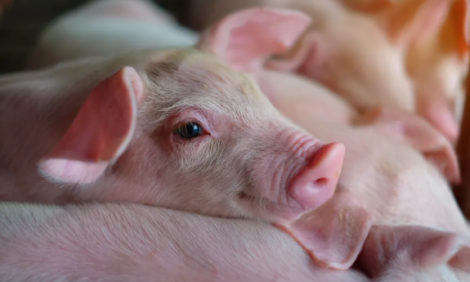



EU-25 Pork Industry Overview, September 2004
By USDA Foreign Agricultural Service - This article provides the pork industry data from the USDA FAS Livestock and Products Annual 2004 report for the EU-25. A link to the full report is also provided. The full report include all the tabular data which we have omitted from this article.Report Highlights
In 2004 and 2005, big changes are expected in the European Union. The Enlargement,
which brought ten new member states into the EU, and the CAP reform, which will change
the support system for farmers, are likely to affect the production of livestock in several
ways. Since 2002, the EU-15 has been a net importer of beef. This trend is expected to
continue, as beef production continues to decrease throughout the EU-25. The CAP reform
sets new rules for production. With the reform, farmers are expected to produce according
to market demand, as farm support payments become independent from production. The
CAP reform also promotes improving environmental, animal welfare and food quality
standards. For the ten new member states, the subsidies system will be phased in over a
10-year period.
On May 1, 2004, 10 New Member States (NMS) joined the European Union (EU), increasing
EU membership from 15 to 25 countries. With the 10 acceding member states - Cyprus, the
Czech Republic, Estonia, Hungary, Latvia, Lithuania, Malta, Poland, Slovakia and Slovenia –
the new EU-25 encompasses 455 million people and land area of over 1.5 million square
miles.
The unprecedented scope of the Enlargement and the recent reform of the Common
Agricultural Policy create exceptional circumstances for forecasting future trends in
production, trade, and consumption.
Many European farmers are still struggling to understand the implications of the new CAP
reform, particularly for beef. Cattle slaughter numbers and beef production in the EU-15 are
projected to increase slightly in 2004, as farmers continue to receive payments under the old
system. With the introduction of decoupled payments in 2005, beef production is expected
to decrease. Pork production will remain largely unaffected by the new CAP measures,
although there could be some indirect effects tied to rising feed costs.
Trade dynamics in the new EU-25 are still evolving. With the removal of trade barriers on
May 1st, buyers from the EU-15 rushed to buy less expensive meat from the NMS. This has
had a significant effect on meat prices. Since 2002, the EU-15 has been a net importer of
beef. This trend is expected to continue for the EU-25, as beef production stabilizes under
the new CAP system, and as the growing volume of intra-EU trade overshadows the
significance of external trade.
According to the EU Commission, new legislation regarding animal transportation, specifying
the length and conditions of travel, should become effective in 2005. However, many believe
that it will be very difficult to keep to the proposed schedule.
Swine
In 2003, EU-15 pig production fell, mainly as a result of record high temperatures during the
summer months, which negatively affected sow fertility. The decrease in pig production was
greater than previously projected (Report E24018). Deteriorating profit margins at the end
of 2003 further exacerbated production conditions. In addition, pig production in the UK
dropped sharply from the previous year’s level due to re-stocking and reduced sow fertility
as a consequence of the presence of PWMS (Post Weaning Multisystemic Wasting Syndrome).
EU statistics indicate that the EU-15 swine inventories fell by about 700,000 animals during
2003. This decrease was also partly due to tightening environmental regulations regarding
manure disposal in the Netherlands and Belgium (600,000 fewer animals), and the low pig
crop in the UK (500,000 fewer animals). However, ending swine inventories increased in
Spain (plus 500,000), Germany (plus 250,000), and Denmark (plus 100,000). Higher than
expected slaughter in Spain also led to an upward revision of the 2003 EU-15 swine
slaughter figures.
The EU-15 pig crop is expected to decline in 2004 due to lower sow beginning stocks. High
feed prices and small profit margins on pig meat production at the end of 2003 and
beginning of 2004 are expected to have a negative impact on total swine slaughter numbers
for 2004. Profit margins are expected to improve during the second half of 2004 and
throughout 2005, particularly as feed grain prices fall. This should spark a recovery in pig
production in 2005.
In 2005, pig stocks are expected to increase in the UK, Denmark and Spain. In the UK, the
breeding herd is expected to recover. Despite increasing environmental restrictions, Danish
swine numbers are expected to follow the historical trend, growing by about one percent a
year. Pig numbers are expected to fall in the Netherlands, Belgium and Germany.
Continuing environmental restrictions are the main reason for declining pig inventories in the
Benelux. The German inventory peaked in late 2003, and is expected to contract during
2004 and 2005 due to declining profitability in the sector.
Poland’s hog cycle is expected to bottom out in the second half of 2004, with a likely
recovery of inventories in 2005. The outlook is similar for Hungary and the Czech Republic.
Hog slaughter and pig meat output are expected to decrease in 2004 due primarily to higher
feed grain prices.
Since joining the EU in May, Hungarian swine imports from the Czech Republic , Poland and
the EU-15 have stopped. Hungarian exports of live swine to Romania, the Ukraine, Croatia
and Bulgaria are also declining. With the decline in Hungarian swine numbers, slaughter has
decreased to a point where Hungary is now utilizing little more than half of its slaughter
capacity of 10 million pigs.
Despite increasing imports from the EU-15, the Czech Republic’s hog supplies are also
inadequate. While live animal trade is expected to soon stabilize, Czech slaughter numbers
are forecast to fall again in 2005. 2005 swine inventories are also expected to fall as more
Czech farmers concentrate their efforts on crop production.
Pig Meat
EU-15 pig meat production is expected to decrease in 2004, mainly as a result of reductions
in the overall breeding herd. The 2003 summer heat wave also appears to have had a longer
lasting effect on sow productivity. While the Enlargement has increased the EU pig herd by
about 18 percent, meat production in the NMS is still catching up to EU-15 standards. In
accession countries like Poland, where pig meat accounts for about 65 percent of total meat
production, a number of slaughter facilities are still working to upgrade their technology.
Without foreign investment, financing upgrades in meat technology is a significant challenge
for smaller abattoir.
During the first half of 2004, pig meat prices have been relatively high. This is expected to
help lift 2005 pig meat production closer to the 2003 level. Also, the anticipated
improvement in feed grain supplies should result in higher slaughter numbers for 2005.
In 2004, EU pig meat imports are expected to decrease by 18 percent. As a result of the EU
Enlargement, Poland is expected to reduce its level of imports from countries outside the EU-
25. Imports of U.S. origin will be very limited, as Poland will be able to only import U.S. pig
meat from plants eligible to export to the EU.
In 2003, EU-15 exports of pig meat declined by almost three percent, primarily as a result of
the Russian Tariff Rate Quota (TRQ) on fresh and frozen pig meat, and strong competition
from Brazil. However, exports to Japan, the main export destination for EU-15 pig meat,
increased by eight percent. Exports to Japan mainly originated from Denmark between April
and August when the pork safeguard was not in effect. Avian influenza in South East Asia
and the trade restrictions in connection with BSE have increased the demand for pig meat on
the world market. Prices are now at the highest level of the last two years. In general,
exports from the EU-15 to Russia are expected to decrease in 2004. The current Russian
TRQ sets a limit for the EU-25 at 227,300 tons for 2004.
Intra-trade with the NMS is expected to increase slightly. Exports from France are expected
to increase (25,000 tons), especially to Asian markets like Japan, Korea, Philippines, and
China. Denmark will also increase exports (40,000 tons) to Japan and Australia, even as
shipments to Russia and the US stagnate. For the first four months of 2004, Danish exports
to Japan increased by 30,000 tons to 120,000 tons, compared to 2003. Even with the pork
safeguard effective from August 1, 2004, Denmark expects to export 270,000 tons of pig
meat to Japan in 2004, up 40,000 tons from the previous year. German exports are forecast
down by 30,000 tons, mainly as a result of diminishing competitiveness in the Russian
market.
After a very strong year for Polish exports in 2003, mainly driven by the pre-accession
liquidation of government stocks, exports are expected to drop substantially in 2004 due
lower hog inventories and lower meat production. Hungarian exports will also decline as pig
meat production has fallen. In early 2004, Hungarian exports to the EU-15 were drastically
reduced as a result of poor price competitiveness. Exports are expected to normalize in the
latter half of 2004 and in 2005. With declining domestic pig meat production in the Czech
Republic, Czech imports from the EU-15 are expected to increase. However, domestic pork
consumption, which stands at about 45 kg. per person, is gradually shifting toward poultry
consumption. This will enable Czech pork exports, directed mainly outside the EU-25, to
grow in 2004.
To view the full report, please click here (PDF)
Source: USDA Foreign Agricultural Service - September 2004








